Intended to serve as lasting mementos for grieving families, these photographs often portrayed the departed in a serene and lifelike repose, creating a poignant connection between the living and the deceased.
It is important to recognize that while postmortem photography did indeed find its place within the cultural landscape of the Victorian era, not every photograph featuring still or composed subjects from that time is a portrayal of the deceased.
The misidentification of live individuals as deceased in these photographs often stems from a combination of factors, including prevailing misconceptions and a desire to sensationalize historical imagery.
The intricate fashions, ornate settings, and posed expressions commonly seen in Victorian photographs contribute to the intrigue surrounding these mislabeled images.
The Victorian era was marked by a heightened sense of formality and decorum, which translated into carefully staged portraits where individuals assumed poised and dignified poses.
Victorian post-mortem photographs were never captured with subjects assuming a standing pose supported by a stand.
The design and structural capacity of posing stands inherently lacked the ability to bear the weight of a deceased body, regardless of its size, making them unsuitable for such a purpose.
Attempting to manipulate a corpse in rigor mortis for posing was impracticable, while a non-rigor body would exhibit a limp and substantial weight, rendering it incapable of sustaining its own head, limbs, or body weight even with the assistance of a stand.
Posing stands, exclusively employed for ensuring subjects’ immobility during prolonged exposures, were ill-suited for accommodating the complex demands of postmortem photography.
These exposures, often lasting up to a minute, required subjects to be in a reclining disposition. In other words, Victorian postmortem photos were always taken in a reclining position, either leaning back in a seated position or lying flat.
While numerous posts on social media have erroneously labeled the subjects depicted in these photographs as deceased, it is crucial to clarify that every individual captured within the images shown in this collection is, in fact, alive.
NOTE: The commentary below is written by Susan Cantrell and was originally published on The Myth of the Stand Alone Corpse blog.
1. Girl Holding Money
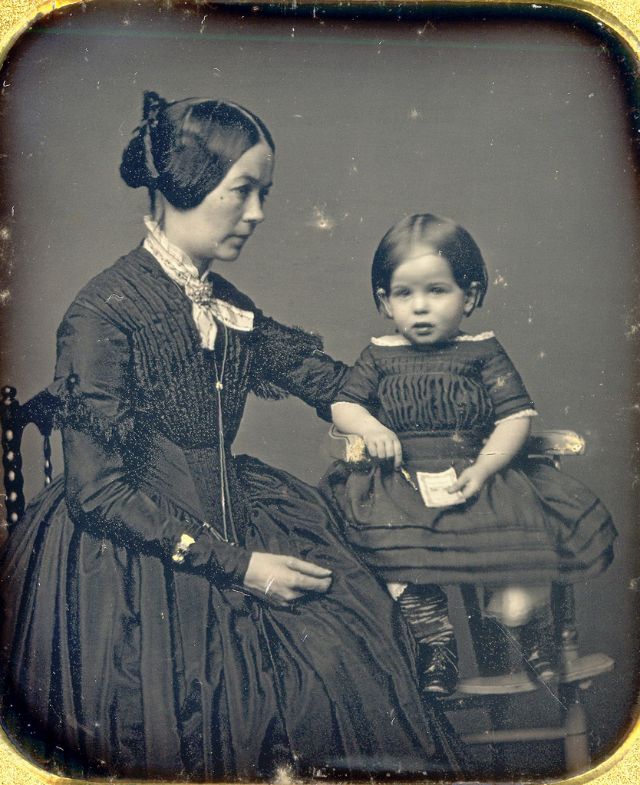 This little girl looks anxious about having her photo taken but she is not deceased. She is even holding some money in her left hand.
This little girl looks anxious about having her photo taken but she is not deceased. She is even holding some money in her left hand.
It was probably given to her to calm and distract her during the photo session. You can also see a large motion blur on her left foot. She was definitely alive.
2. Mysterious Woman
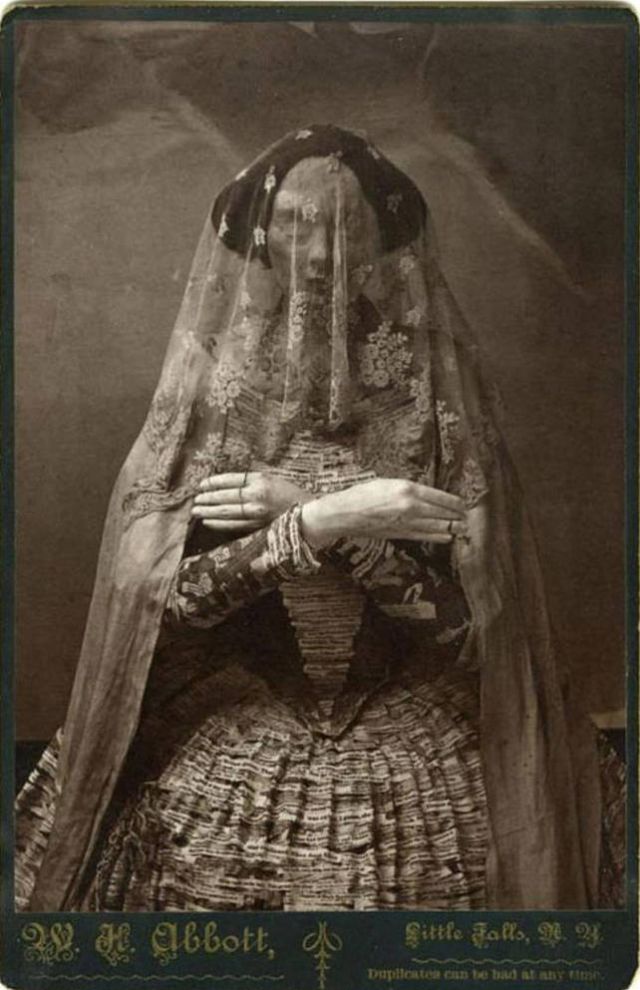 Some say this is the corpse of a famous clairvoyant. However, it is a sculpture by Christine Elfman made of plaster and paper mâché.
Some say this is the corpse of a famous clairvoyant. However, it is a sculpture by Christine Elfman made of plaster and paper mâché.
The dress is made of torn pieces of paper with the story of her family. Zoom and you can see the words. Not a postmortem.
3. Well-Dressed Boy
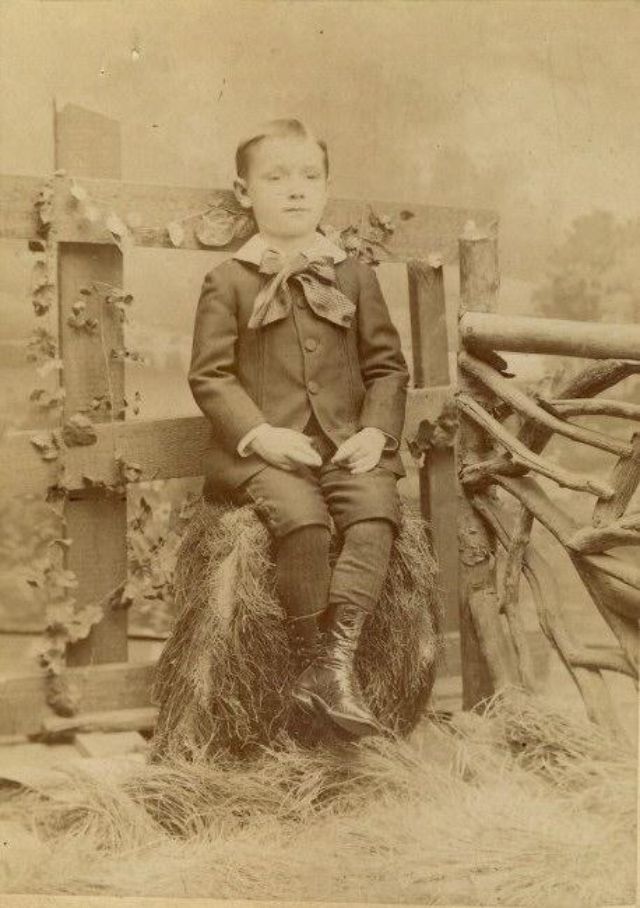 This is another one that mystifies us. We see nothing that suggests this boy was dead.
This is another one that mystifies us. We see nothing that suggests this boy was dead.
He’s alert, holding his head up, and looking at the camera.
4. Not Victorian, But Quite A Story
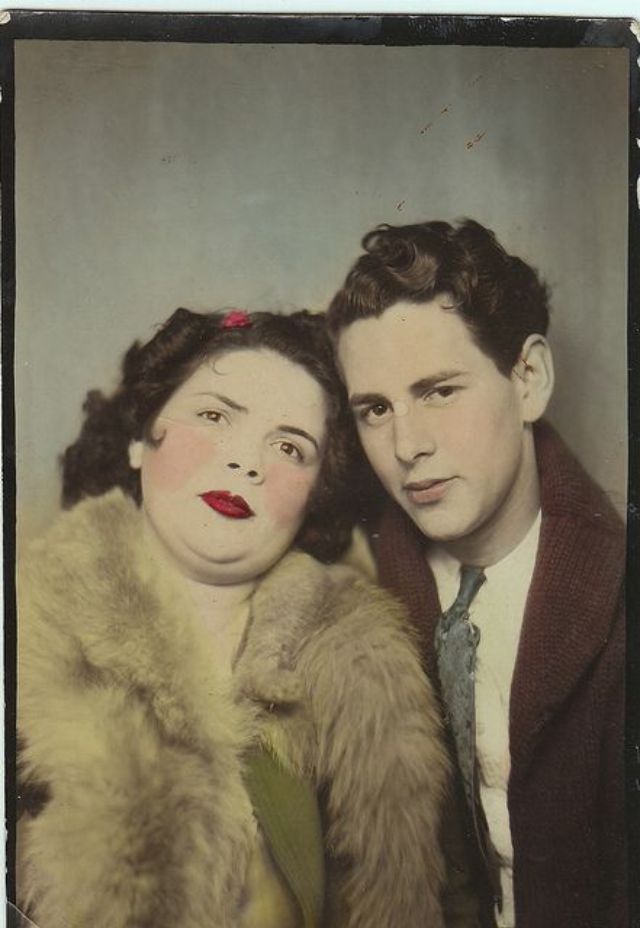 This couple was not Victorian, and they were not dead. Someone made up a big story about the woman being dead two days, and the man, being in denial, and having a photo made.
This couple was not Victorian, and they were not dead. Someone made up a big story about the woman being dead two days, and the man, being in denial, and having a photo made.
It is actually a photo booth photo that has been tinted.
5. The Bride
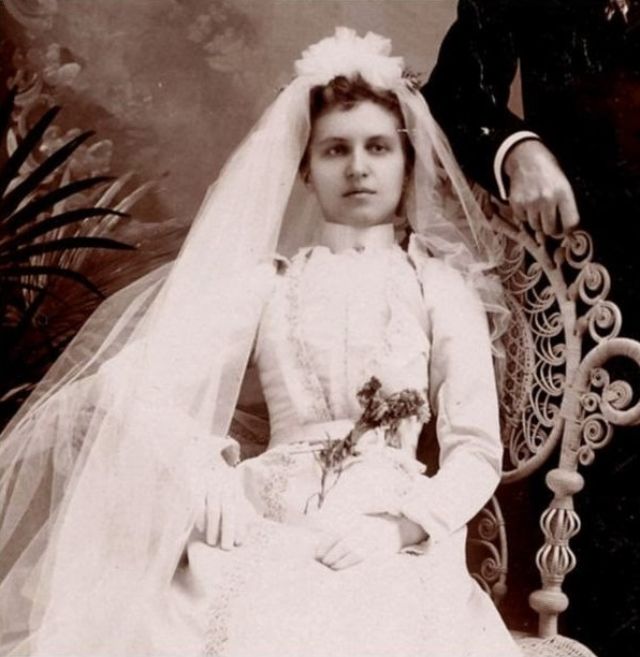
This bride is stiffly posed but she was alive, with her groom standing next to her. Her dried flowers do not mean death.
They were an accepted embellishment, especially in the hot summer months when it was hard to keep flowers fresh.
6. Artistic Photo
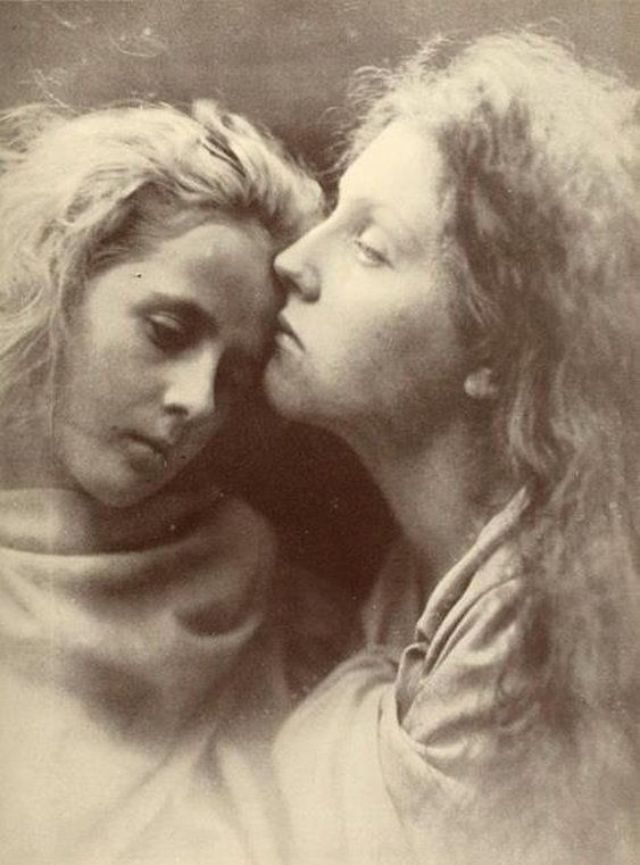 This photo of two women is an artistic portrait. It is called, ” The Kiss of Peace” – 1869, by Julia Margaret Cameron, a talented early woman photographer. They were both alive.
This photo of two women is an artistic portrait. It is called, ” The Kiss of Peace” – 1869, by Julia Margaret Cameron, a talented early woman photographer. They were both alive.
7. Baby With Mother
 The baby is sleeping. The writing on the back of the photo says, “Taken September 12th, 1854. The child was 28 days old.”
The baby is sleeping. The writing on the back of the photo says, “Taken September 12th, 1854. The child was 28 days old.”
8. Seated Girl With Doll
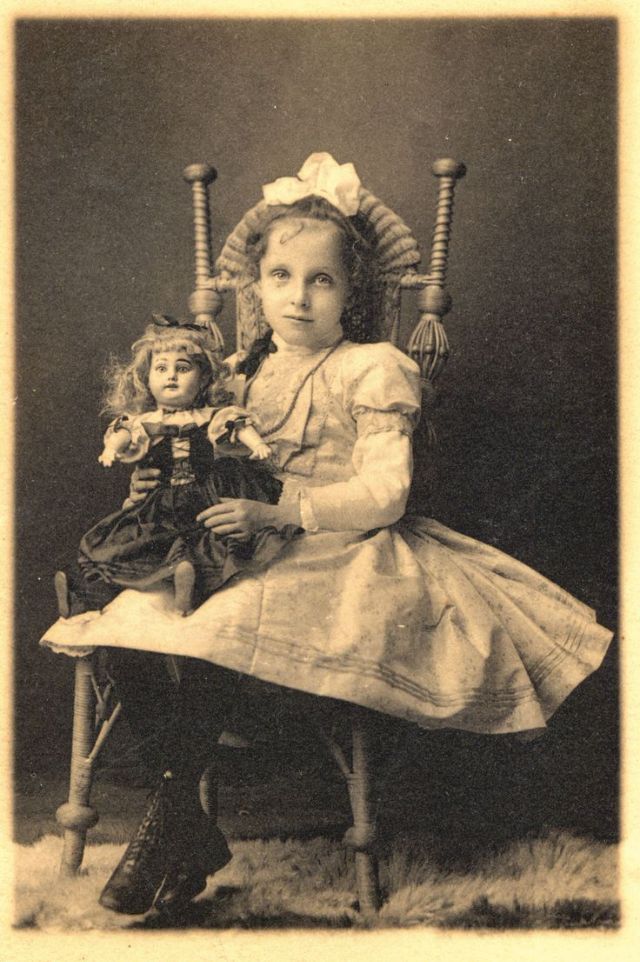 We have no idea why this one is being mislabeled as “deceased”. It makes no sense at all.
We have no idea why this one is being mislabeled as “deceased”. It makes no sense at all.
9. Flash Misfire
 People say the dark color of the girl’s arms and the dark circles under her eyes are evidence that this is a postmortem photo when actually the darkness is from a misfire of the flash.
People say the dark color of the girl’s arms and the dark circles under her eyes are evidence that this is a postmortem photo when actually the darkness is from a misfire of the flash.
10. Squirming Children
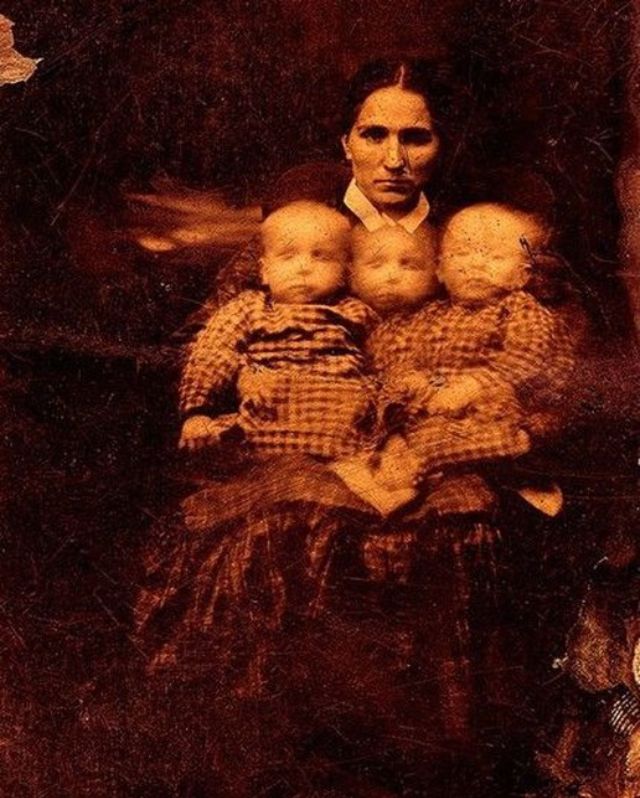 No one in this photo is dead, but it does illustrate why it is important to keep children still for long shutter exposures. There were only two children in this photo.
No one in this photo is dead, but it does illustrate why it is important to keep children still for long shutter exposures. There were only two children in this photo.
11. Innsmouth Woman
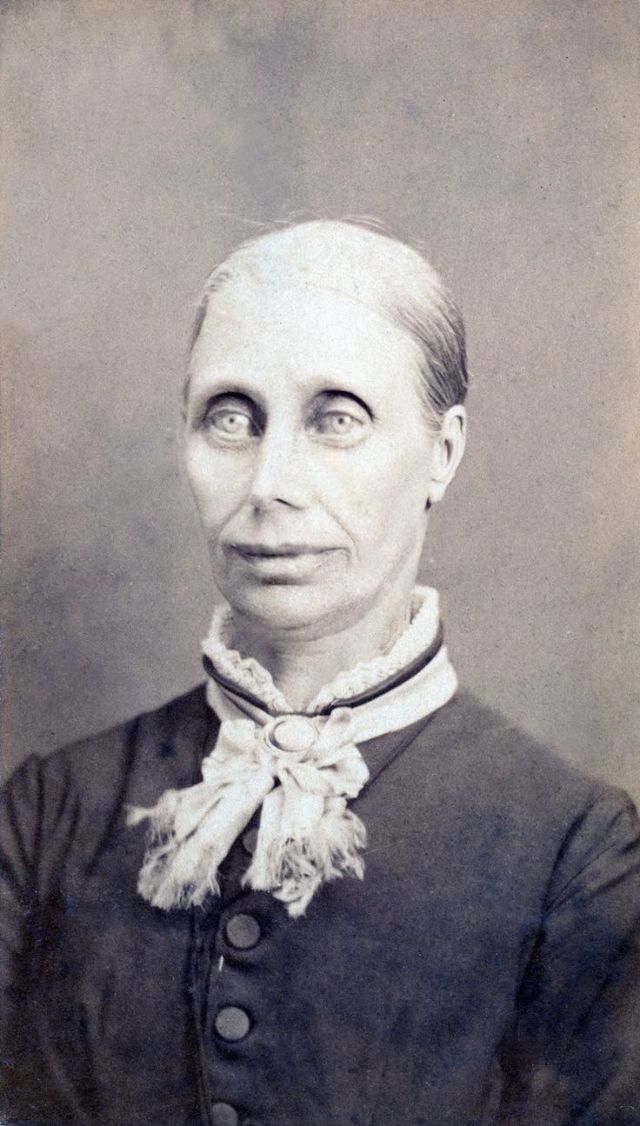
This is not a dead person, and it is not a person at all.
It is a fictional depiction of a character from The Shadow over Innsmouth, a horror novella by H. P. Lovecraft, written in November–December 1931.
12. Day Dreaming
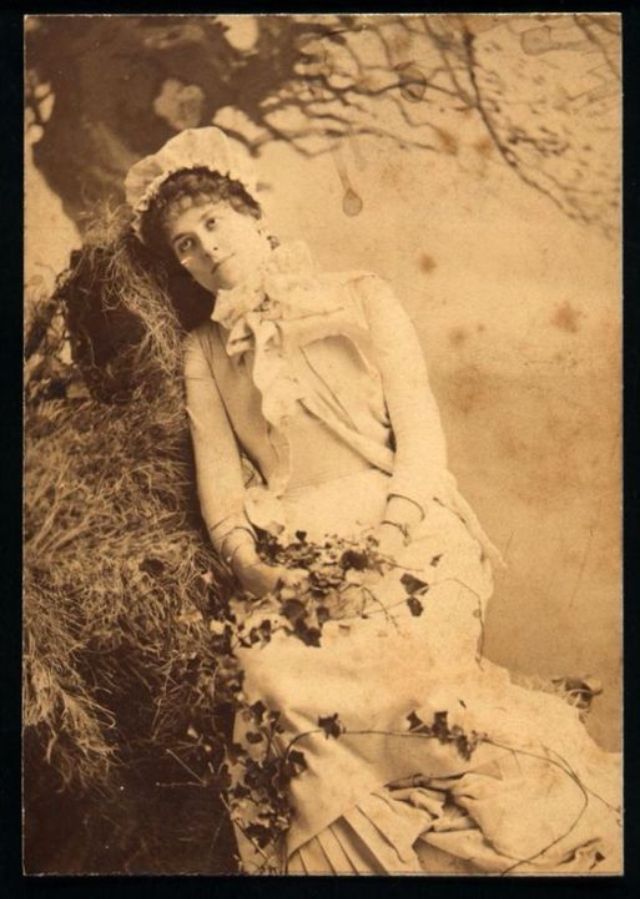 This is a romanticized photo of a daydreaming young woman. She was very much alive. Flowers do not mean death.
This is a romanticized photo of a daydreaming young woman. She was very much alive. Flowers do not mean death.
13. War Pageant Photo
 This photo was staged to show the tragedy of war. No one in it was dead.
This photo was staged to show the tragedy of war. No one in it was dead.
This was a bit too elaborate to be a real postmortem photo.
14. Framed Twins
 The stands behind these two assure us that they were alive. They do look a bit startled, probably from the flash.
The stands behind these two assure us that they were alive. They do look a bit startled, probably from the flash.
15. Girl With Look Alike Doll
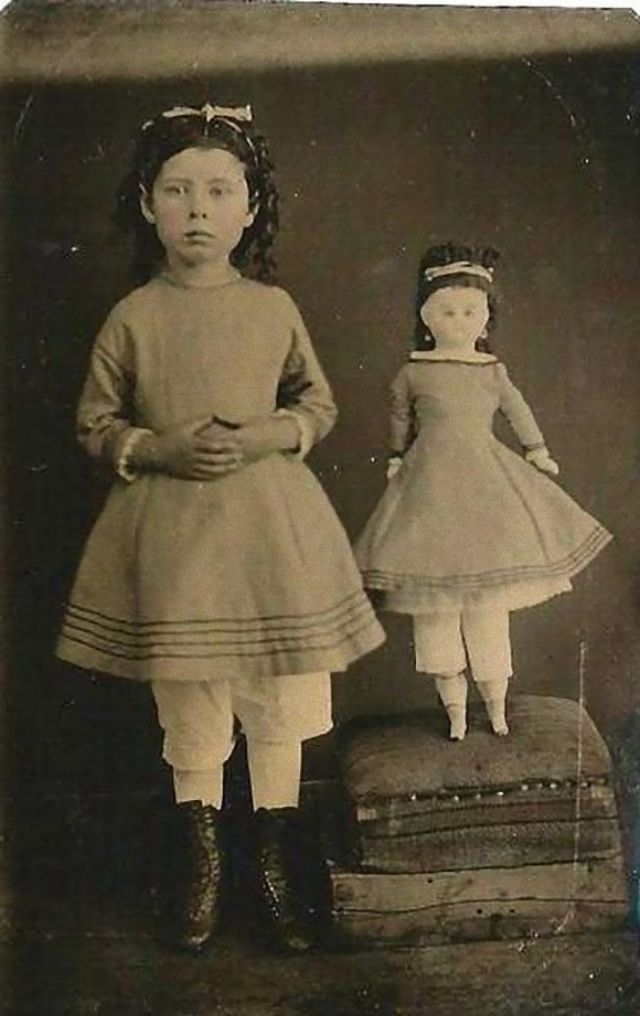 Standing, with her hands folded, this little girl was alive, and showing off her look-alike doll.
Standing, with her hands folded, this little girl was alive, and showing off her look-alike doll.
Folded hands do not always mean death in photos.
16. A Christmas Dream
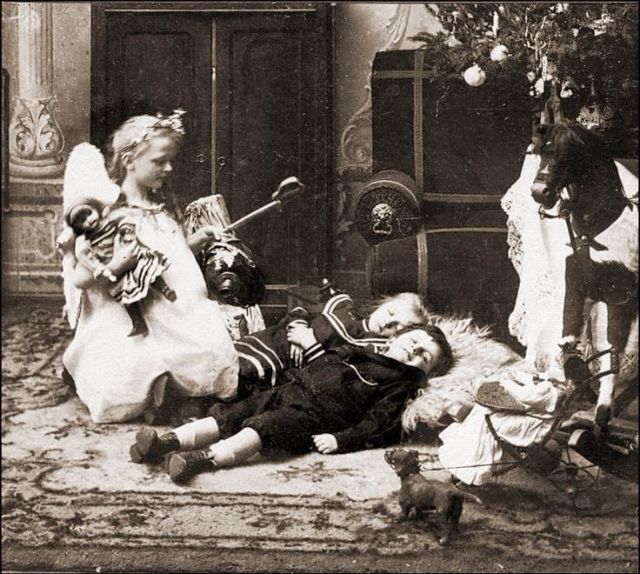 This is not a death photo, it is a pageant photo called, “A Christmas Dream”.
This is not a death photo, it is a pageant photo called, “A Christmas Dream”.
The children are pretending to sleep and dream, the boy is even smiling. Note the Christmas tree in the upper right portion of the photo.
17. A Portrait of a Young Woman
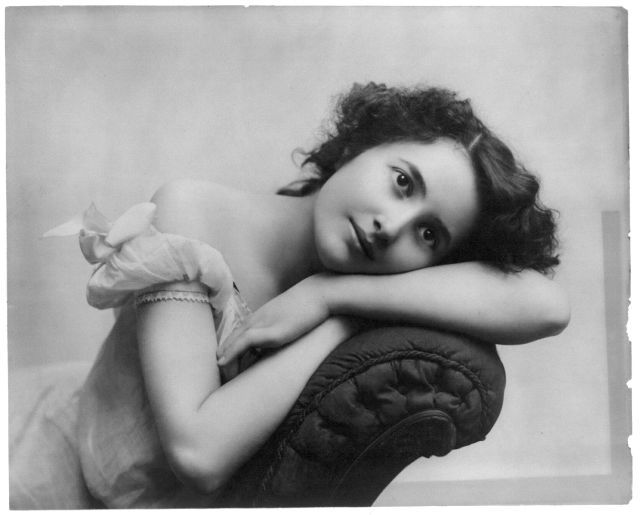 So many people post this online with a long caption saying this was a postmortem taken right after death.
So many people post this online with a long caption saying this was a postmortem taken right after death.
It is no such thing. Its title is “A portrait of a young woman” by Fritz W. Guerin, c. 1902.
18. Young Man Gripping Table
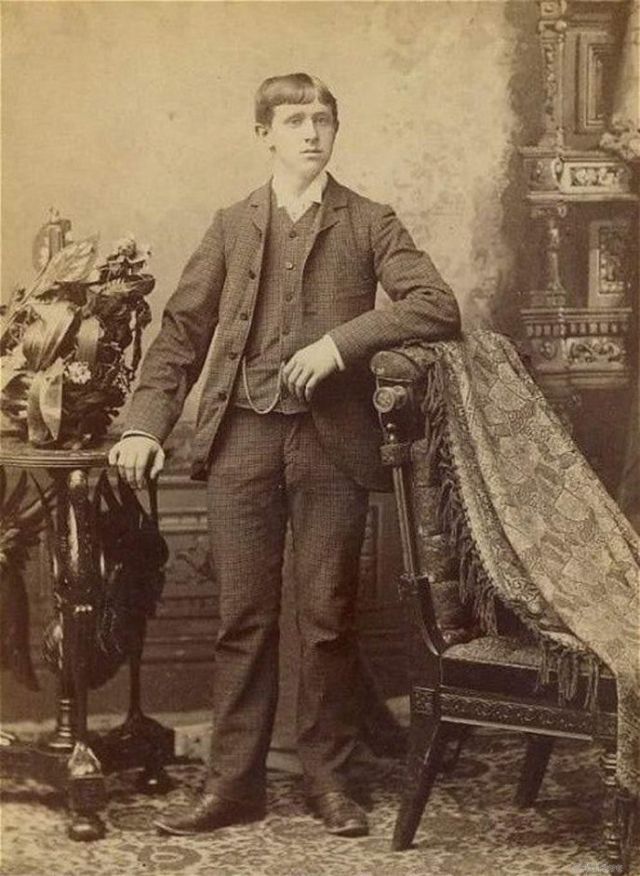 Standing tall, with his right hand gripping a table and his left elbow leaning on a chair, we know he must be alive.
Standing tall, with his right hand gripping a table and his left elbow leaning on a chair, we know he must be alive.
19. Sleeping Baby
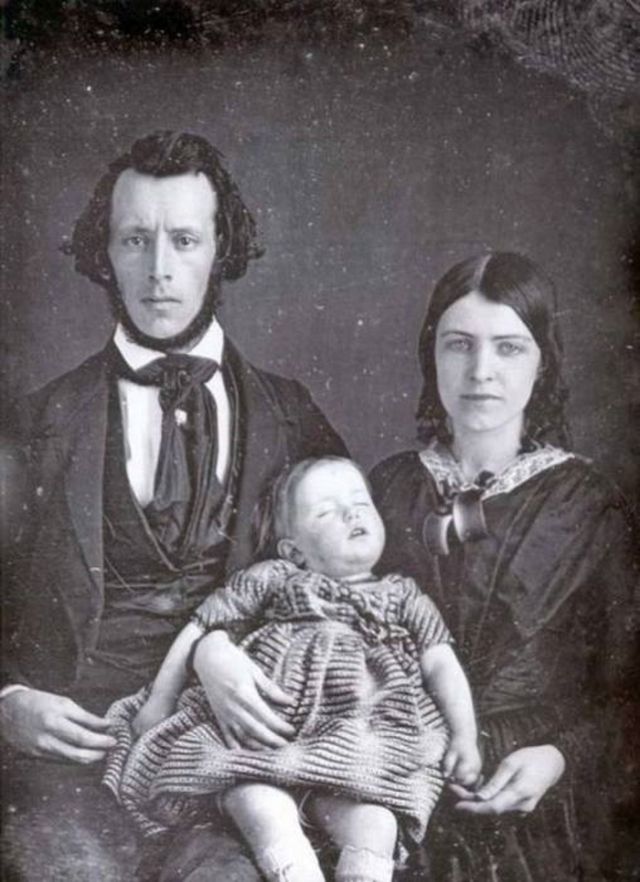 The info with the original photo says: “Here we present a historic image of Adams family portrait, with man, woman, and baby girl. It was taken in 1846. The image shows Adams, Henry Joseph. Adams, Abigail Ridley Gibson. Kingsbury, Anna Gibson Adams, 1845-1884.”
The info with the original photo says: “Here we present a historic image of Adams family portrait, with man, woman, and baby girl. It was taken in 1846. The image shows Adams, Henry Joseph. Adams, Abigail Ridley Gibson. Kingsbury, Anna Gibson Adams, 1845-1884.”
Nothing was mentioned about death, nobody looks like they are in mourning and the child looks healthy. Everyone with closed eyes is not dead!
20. Seated Woman With Umbrella
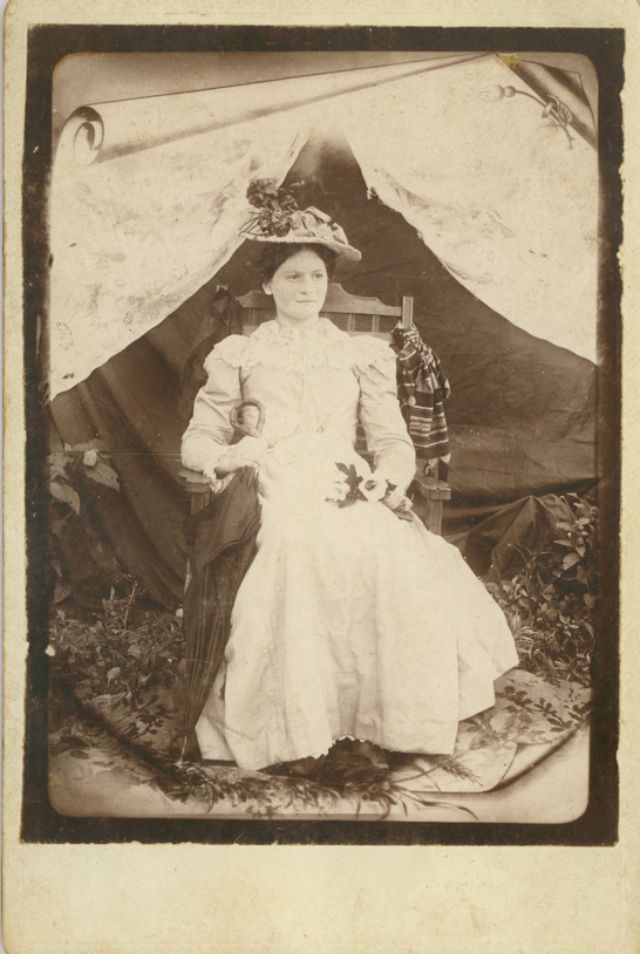
Just because her image has been embellished, it does not mean she was dead. She is sitting tall and hanging onto an umbrella.
21. Mother and Child
 Some say the child is hugging her deceased mother, but you can see her mother’s hand is blurred on her back from motion. The woman is also holding herself upright. She was alive.
Some say the child is hugging her deceased mother, but you can see her mother’s hand is blurred on her back from motion. The woman is also holding herself upright. She was alive.
22. Boy With Flowers
 It looks like someone is behind the curtain holding his head, but he standing alone and is alive.
It looks like someone is behind the curtain holding his head, but he standing alone and is alive.
23. Damaged Photo of Baby
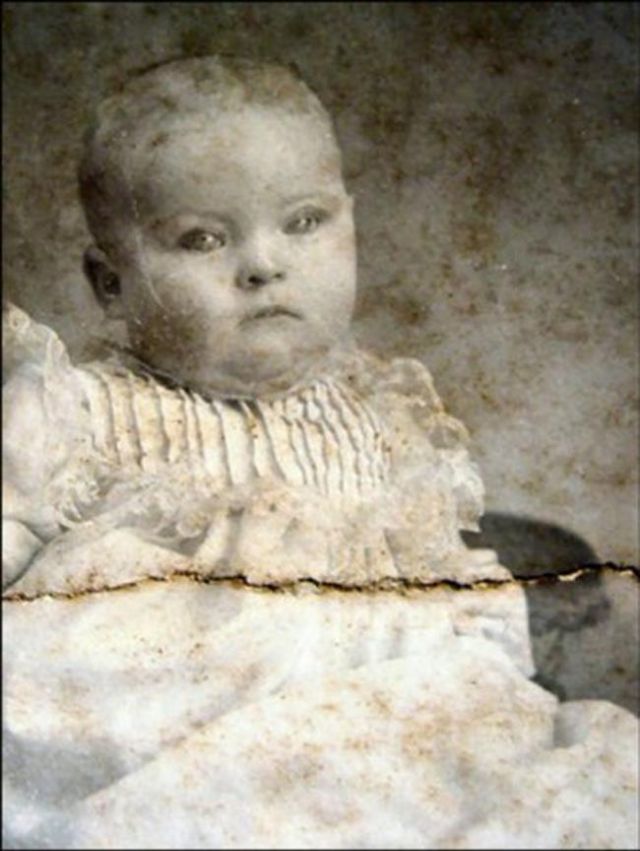 This photo is damaged and has some foxing but the baby is sitting up and holding up its own head.
This photo is damaged and has some foxing but the baby is sitting up and holding up its own head.
We see no reason to think this baby is deceased.
24. Three Young Men
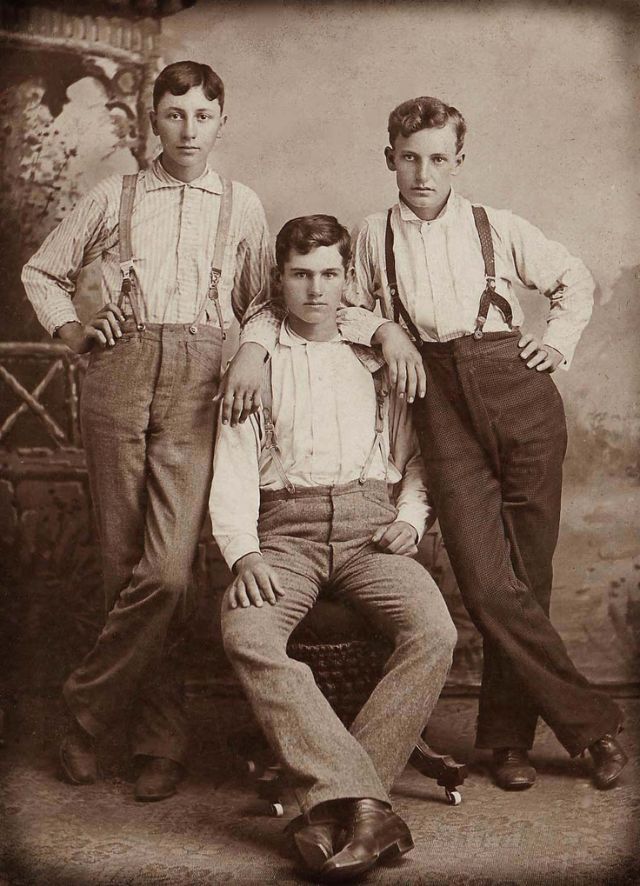 How could these young men look any more alive? It’s hard to believe that the middle one is labeled as deceased on many posts throughout social media.
How could these young men look any more alive? It’s hard to believe that the middle one is labeled as deceased on many posts throughout social media.
25. Handicapped Girl
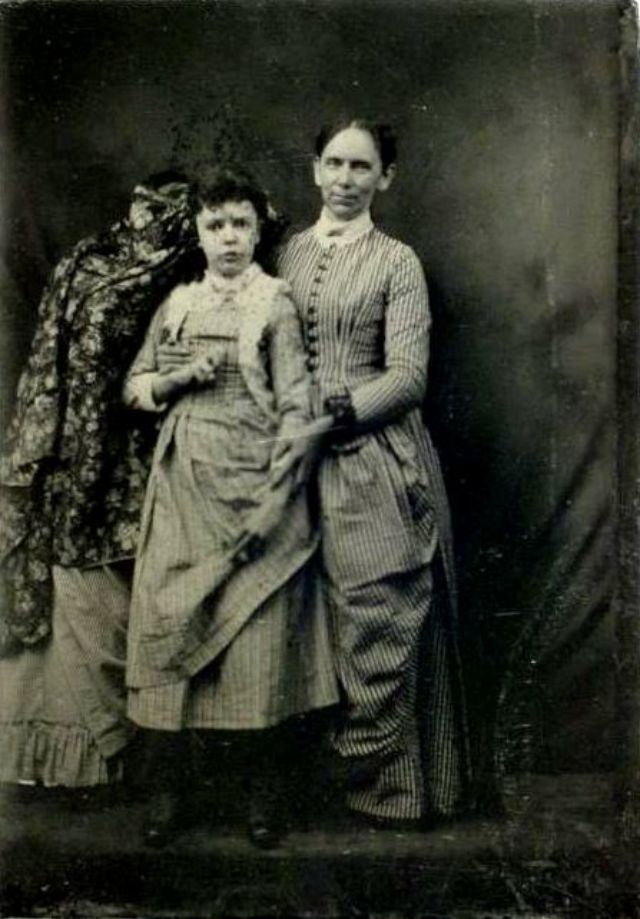 This young woman was alive. She has two attendants, one is cloaked because she does not want to be in the photo.
This young woman was alive. She has two attendants, one is cloaked because she does not want to be in the photo.
26. Eerie Eyes
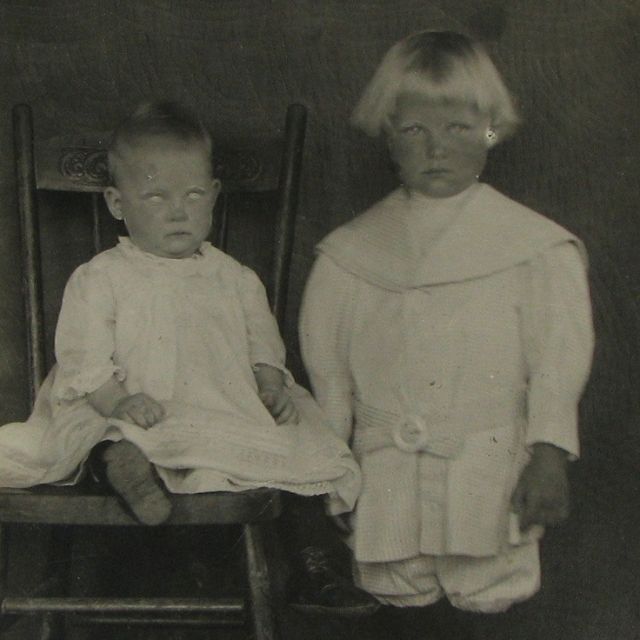 Yes, their eyes do look weird but they were alive. They are very blond with light blue eyes that do not register well with the old camera and flash used for this picture.
Yes, their eyes do look weird but they were alive. They are very blond with light blue eyes that do not register well with the old camera and flash used for this picture.
27. Boy With Cane
 He’s standing alone and sitting astride a cane like a hobby horse. This pose helped the lively little boy hold still. He was not deceased.
He’s standing alone and sitting astride a cane like a hobby horse. This pose helped the lively little boy hold still. He was not deceased.
28. Prince Albert Victor of Wales
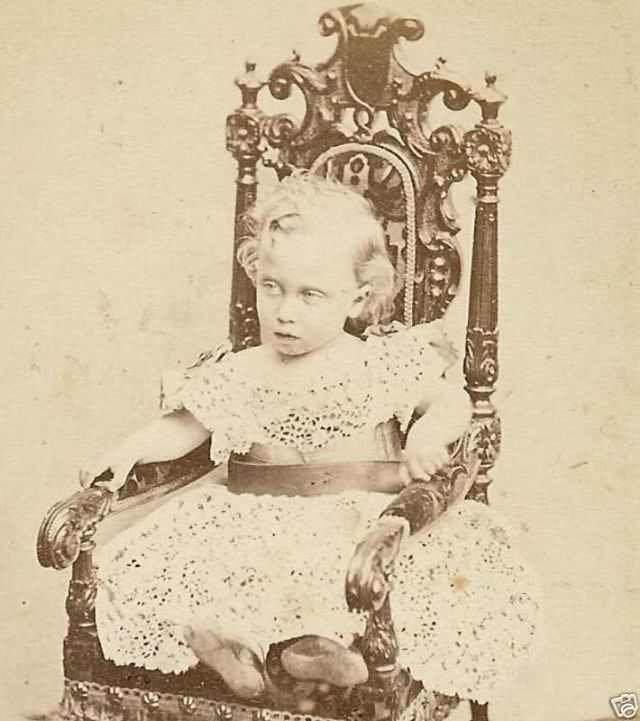 This child has been identified as Prince Albert Victor of Wales, Duke of Clarence and Avondale. He died at age 28 in 1892.
This child has been identified as Prince Albert Victor of Wales, Duke of Clarence and Avondale. He died at age 28 in 1892.
29. Four Sisters
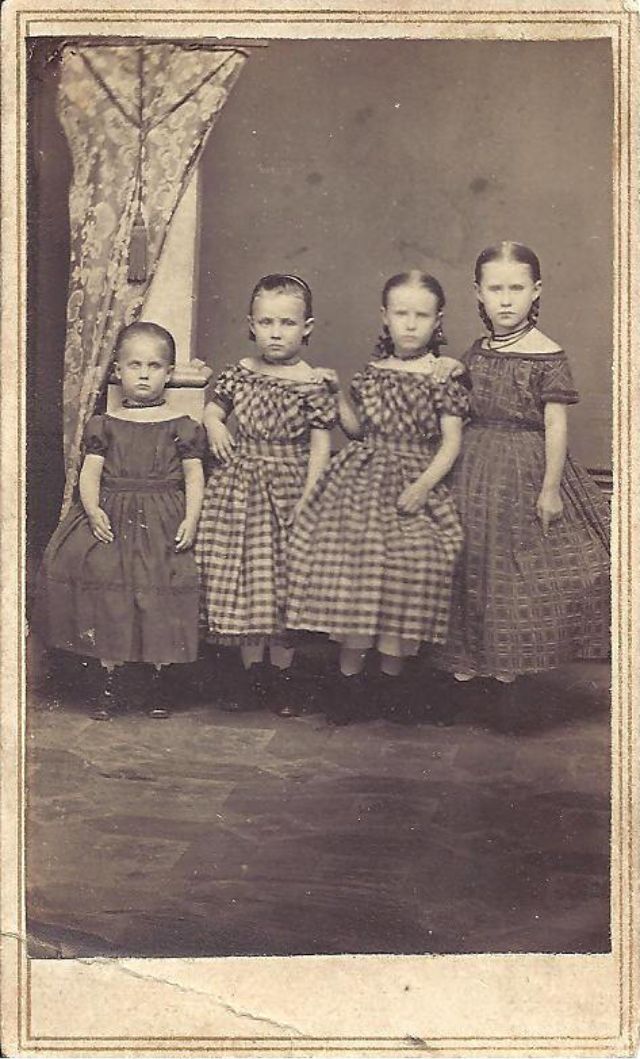 Some think the girl on the left is deceased. For some reason when children are lined up like this people always seem to think that the little one is dead! However, she is standing so we know she is alive.
Some think the girl on the left is deceased. For some reason when children are lined up like this people always seem to think that the little one is dead! However, she is standing so we know she is alive.
30. Spirit Photo
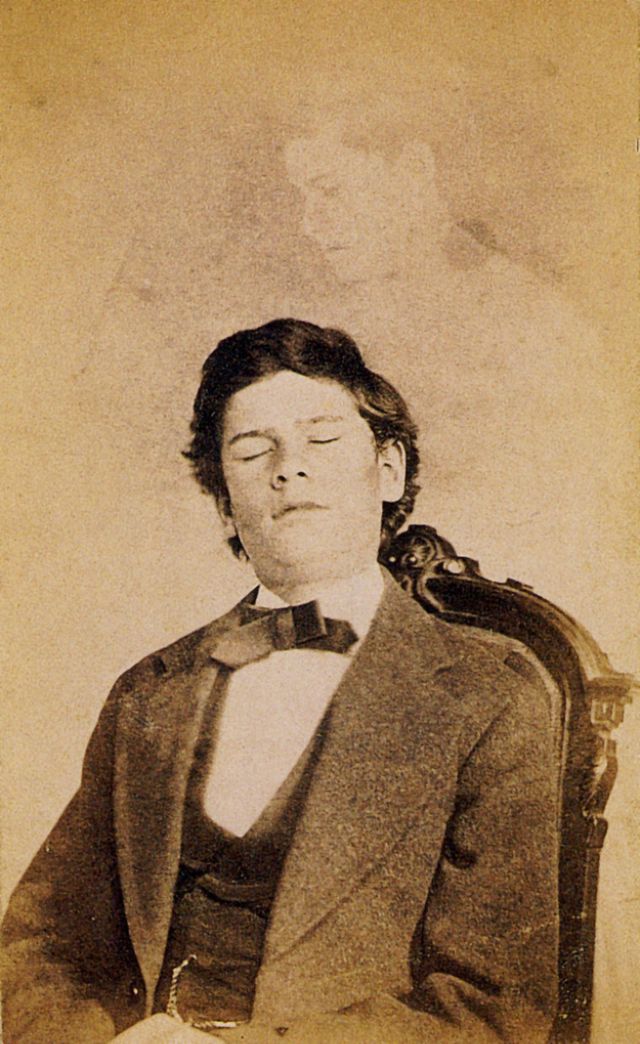 Do you see the spirit image in the upper right-hand corner of this photo? This is a staged photo of a live man who is supposedly in a trance to bring the spirit to him.
Do you see the spirit image in the upper right-hand corner of this photo? This is a staged photo of a live man who is supposedly in a trance to bring the spirit to him.
Spirit photos were popularized as soon as photographers were able to fake them by printing double negatives.
31. Girl on Chair
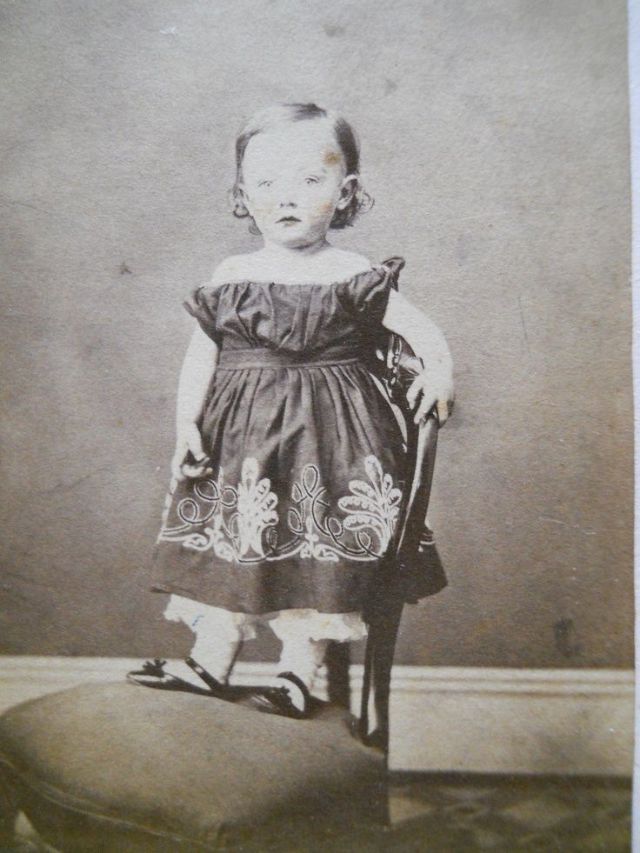 This little girl was alive. Her face was a little washed out due to uneven flash coverage but you can clearly see her hanging onto the chair with her left hand.
This little girl was alive. Her face was a little washed out due to uneven flash coverage but you can clearly see her hanging onto the chair with her left hand.
32. Girl With Purse
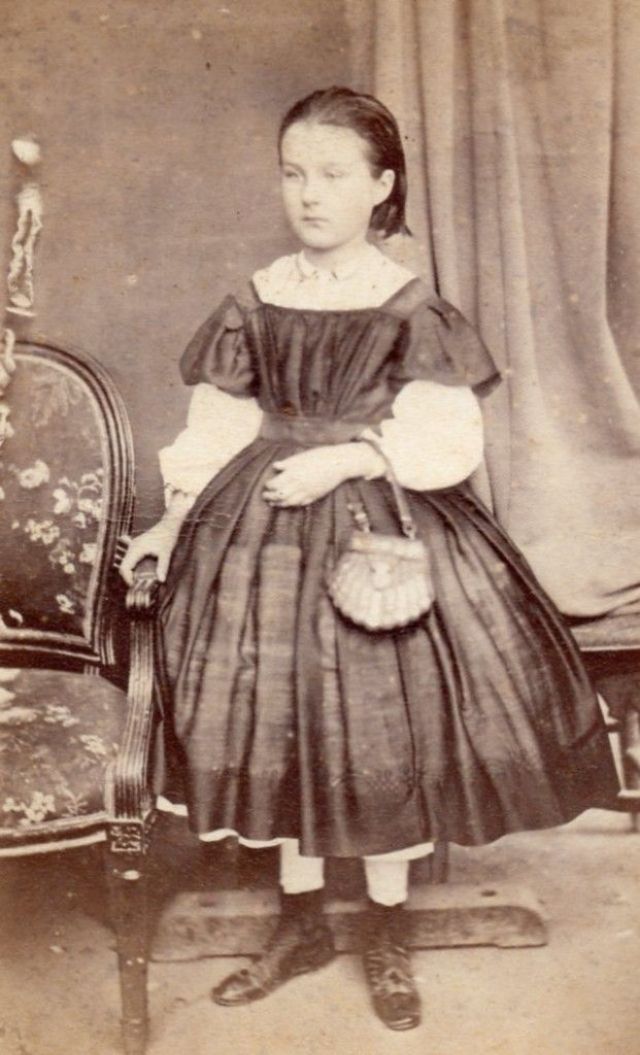 The posing stand behind her means she was alive and trying to hold still for the camera.
The posing stand behind her means she was alive and trying to hold still for the camera.
33. Baby in Mourning
 Because this baby has a dark ribbon affixed to its back, many people are saying he/she was dead.
Because this baby has a dark ribbon affixed to its back, many people are saying he/she was dead.
In fact, dark ribbons were often pinned to babies and small children if a relative of theirs died. In this photo, it looks as if the mother was also in mourning.
34. Unhappy Girl With Doll
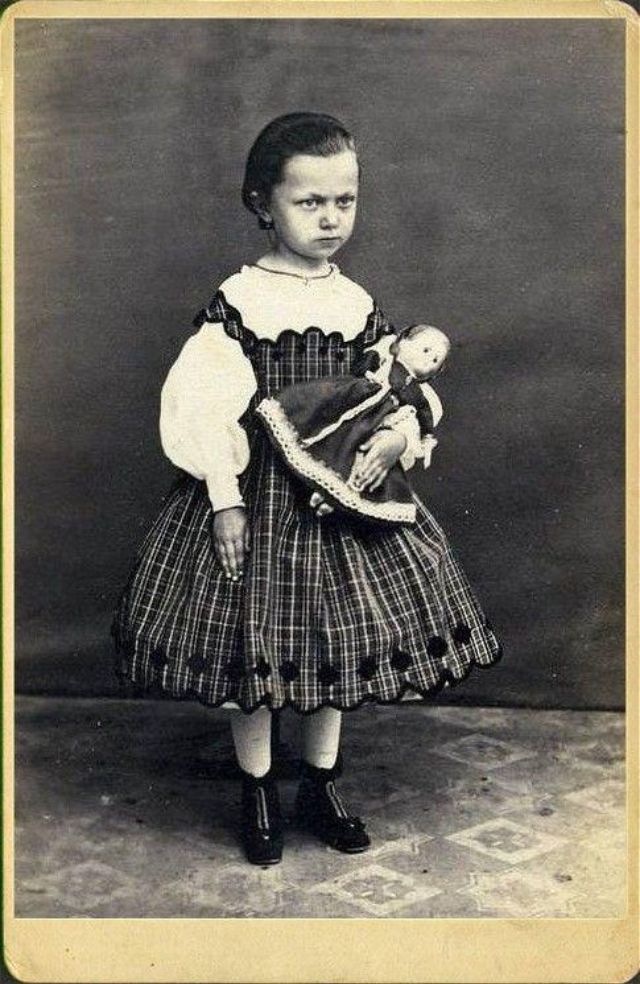 This girl looks pretty unhappy about her photo but she was not deceased.
This girl looks pretty unhappy about her photo but she was not deceased.
Photographers would often pose their subjects with stiff hand poses because the stiff pose was easier to hold.
35. Two Girls and a Swing
 Both of these little ladies were alive and well. Victorians seldom smiled in photos, they thought it was undignified.
Both of these little ladies were alive and well. Victorians seldom smiled in photos, they thought it was undignified.
36. Girls With Their Toys
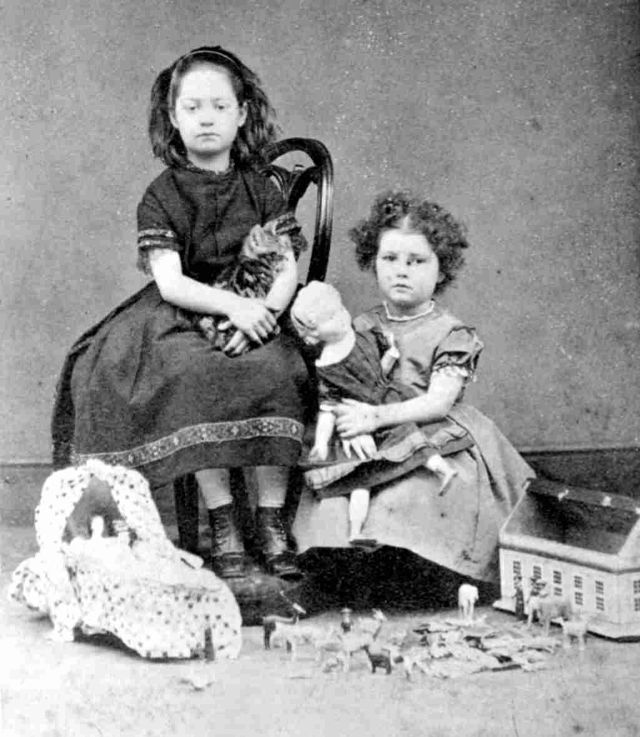 This photo of two girls and their toys features two live girls and their precious toys. Nothing here suggests either one is deceased.
This photo of two girls and their toys features two live girls and their precious toys. Nothing here suggests either one is deceased.
37. Identical Twins
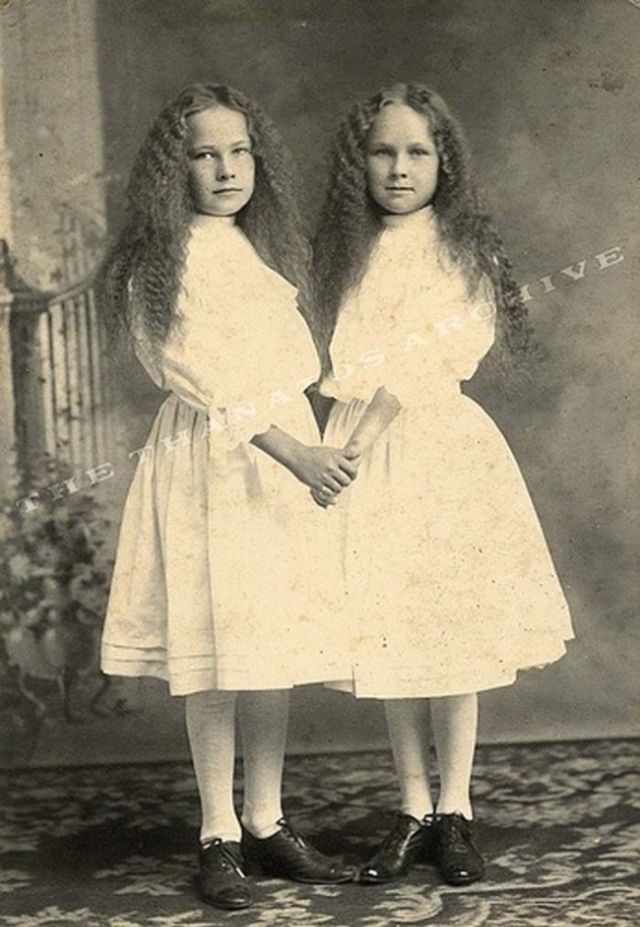 These beautiful twins were alive, holding up their heads and looking straight at the camera.
These beautiful twins were alive, holding up their heads and looking straight at the camera.
38. Courting Couple
 Many people have identified this lady as being dead simply because she has closed her eyes.
Many people have identified this lady as being dead simply because she has closed her eyes.
The facts that she is holding up her own head and sitting upright demonstrate that those people are wrong.
39. Breast Feeding Mother
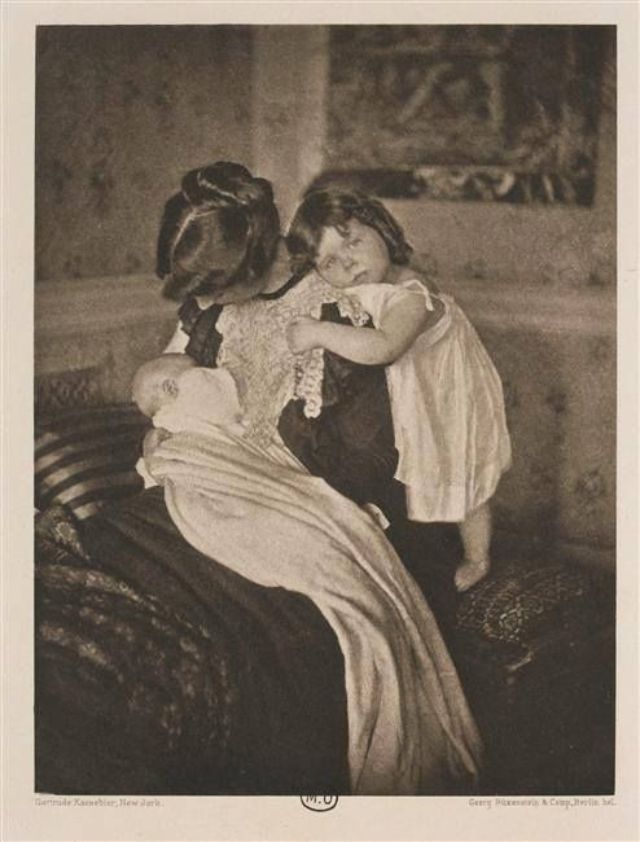 Some think this is a mother holding a deceased infant, but if you look closely you can see that the mother is breastfeeding. The older child probably just wants her mother’s attention.
Some think this is a mother holding a deceased infant, but if you look closely you can see that the mother is breastfeeding. The older child probably just wants her mother’s attention.
40. Charles Lutwidge Dodgson
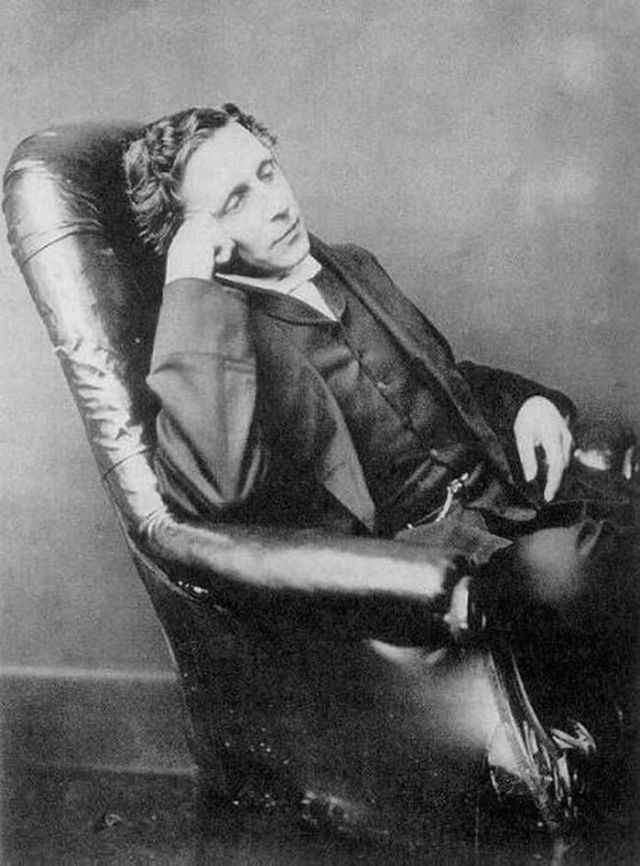
Although this photo is often labeled as a photo of a dead man, it is not.
It is a photo of the famous author Charles Lutwidge Dodgson (known as Lewis Caroll) who wrote “Alice’s Adventures in Wonderland.” And, he was alive when it was taken.
(Photo credit: Susan Cantrell via They Myth of the Stand Alone Corpse).